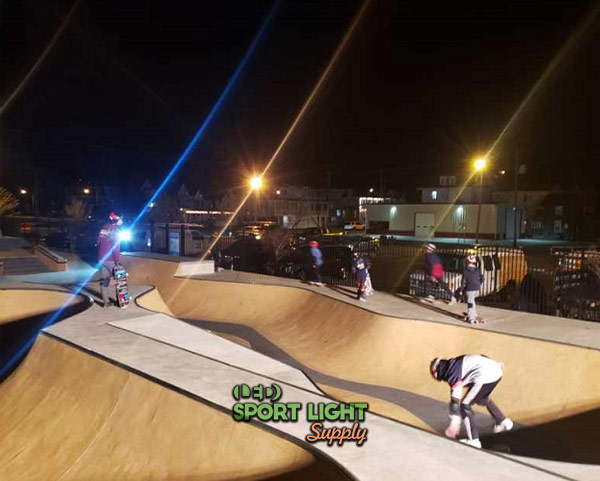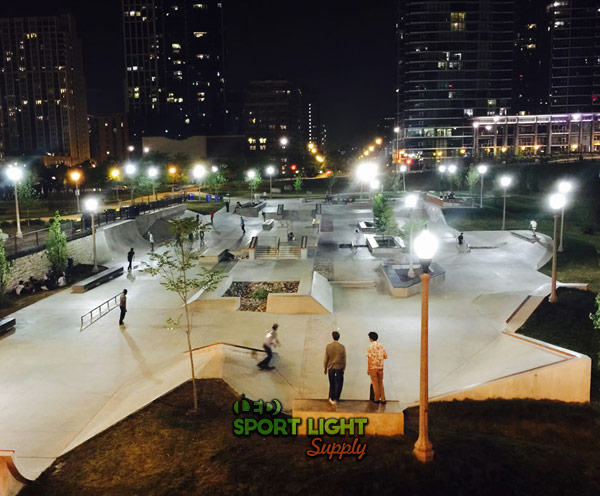State regulations for visual comfort in skate parks typically mandate that light poles be between 9 and 15 feet in height. However, the design of the skate park itself is the most critical factor to consider. This is because skate parks can feature both flat and intricate skating environments, which significantly influence lighting requirements.
Table of Contents
ToggleThe Shape and Size of the Skate Park

Impact of Skate Park Shape on Pole Height
The shape of a skate park has a significant impact on the height of the light poles. A flat skate park might include low ramps, flat bars, down rails, and other basic transitional elements. In contrast, a more advanced skate park may feature complex elements such as a full pipe, multiple pools, over-vert extensions, and stairs. From a lighting design perspective, a park with numerous ledges and ramps will cast more shadows. These shadows necessitate consistent lighting uniformity to ensure proper visibility.
The presence of multiple shadows complicates the lighting layout, often requiring taller light poles. Generally, the taller the pole, the wider the illuminated area. However, with increased pole height, more light sources are needed to compensate for light loss.
Light Distribution and Aesthetics
Short poles in a skate park can cause glare, which may hinder skateboarders’ vision. Conversely, tall poles might disrupt the park’s landscape aesthetics. Typically, shorter poles are used for security lighting and equipped with shielded fixtures. High mast lighting, which includes both floodlights and spotlights, is often employed to cover the entire skating area.
Several states mandate that the type of lighting system used at night be communicated to the public. Choosing the appropriate pole height can influence factors such as traffic and operating hours. High mast lighting is generally the best option for meeting the required lux levels for safe skateboarding.
If budget constraints prevent the installation of a high mast lighting system, short poles can provide sufficient lighting to extend park usage during the summer evenings. In such cases, signage should inform the public about potential lighting inadequacies until more permanent high mast lighting can be installed.

Maintenance Costs
Tall light pole systems typically incur higher maintenance costs compared to shorter pole designs. This is primarily due to the increased number of fixtures installed on high masts.
In locations with complex features, such as euro gaps or mega ramps, high-power LED fixtures may need to be mounted on distant poles. This requires regular maintenance to ensure safety and optimal lighting quality.
Most outdoor lighting solutions use LED fixtures, which have a long lifespan. However, high masts can attract birds, which roost and preen near the fixtures, causing potential dirt buildup. This dirt can lead to overheating or reduced light output, necessitating anti-roosting spikes and regular cleaning.
Tall light poles are susceptible to lightning strikes, which can be hazardous. To protect the lighting equipment, installing a lightning rod is essential, though this will increase overall costs.
Light Pole Height and Requirements
When a skate park owner aims to host professional skateboarding events, they must adhere to specific lighting requirements to ensure optimal performance and visibility. Achieving ideal lighting uniformity becomes challenging without tall light poles, particularly for international competitions that involve broadcasting.
With a 10-foot tall mast, it is feasible to install fixtures equipped with wide asymmetrical beams. This setup allows for the use of fewer, yet higher-quality LED fixtures that are DALI-compatible and have a suitable CRI rating (Ra ≥ 85). The Digital Addressable Lighting Interface (DALI) is a control protocol that simplifies the management of the lighting system, making it easy to turn lights on and off as needed.
Since a skate park can span up to 13,000 square feet, the height of the light poles plays a crucial role in the final layout. To prevent light pollution and minimize energy wastage, a photometric analysis is often conducted. This analysis helps determine the most efficient lighting design from the outset of the skate park project.
Other Considerations
The design and layout of the skate park, including the number of ramps, bowls, and pipes, affect the walking paths between different areas. In cases where light poles may be too distant, solar lights can provide additional illumination.
Besides, the choice of luminaire types may require a fixed pole height due to the weight or specifications of the fixtures. The material used for the poles can also impose similar restrictions.
For the best lighting design outcomes, hiring professional designers is highly recommended. Expert designers often use DIALux software to create effective lighting designs, addressing and mitigating any construction issues or limitations before they arise.
Conclusion
Achieving optimal lighting for a skate park, especially for professional events, involves careful consideration of light pole height and design. Taller poles facilitate better uniformity and efficiency, essential for high-quality lighting and broadcasting requirements. Photometric analysis and expert design are crucial in minimizing light pollution and ensuring effective illumination across large areas. Professional designers, using advanced tools like DIALux, can provide tailored solutions that meet both functional and aesthetic needs, ensuring a well-lit and engaging skate park environment.
